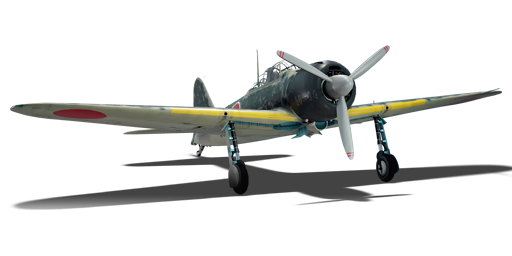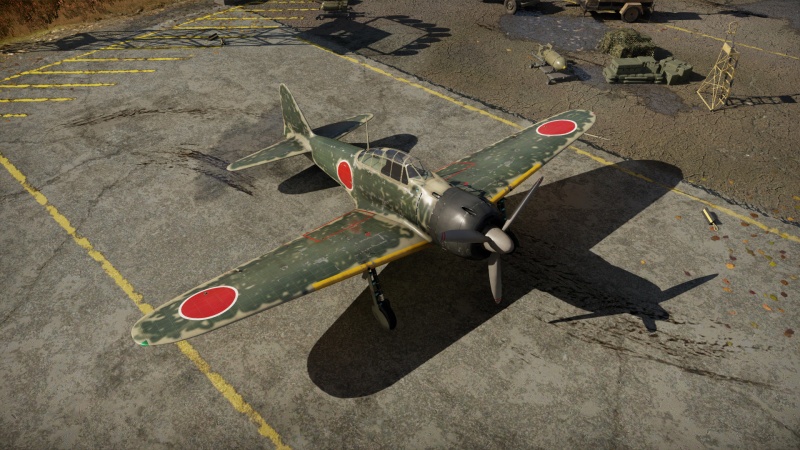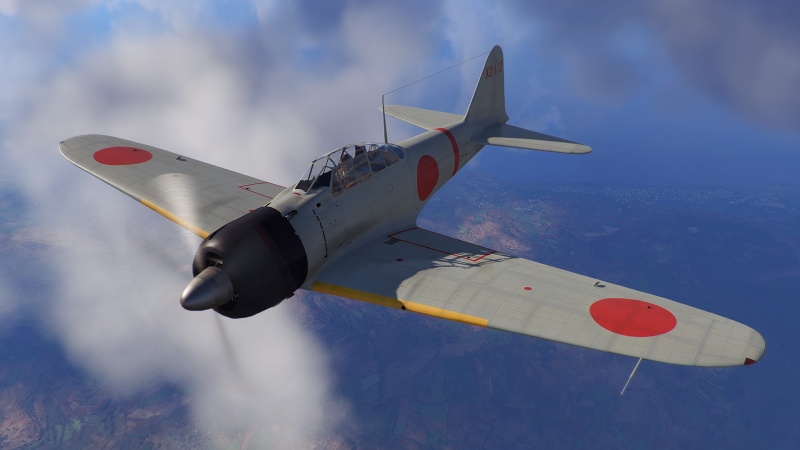A6M3 mod. 22
| This page is about the Japanese fighter A6M3 mod. 22. For other versions, see A6M (Family). |
Contents
Description
The A6M3 mod. 22, designated as the Type 0 Carrier-based Fighter Model 22 (零式艦上戦闘機二二型), was a modification of the A6M3 mod. 32 that aimed to address its shortcomings. It restored the wings of the A6M2 mod. 21, which had full-sized ailerons and folding wing tips, and compensated for the reduced main fuel tank size by adding extra fuel tanks to the outer wings. This improved its long-range performance. The 20 mm cannon 100-round drum magazines and the upgraded engine from the Model 32 were kept, as the Sakae 21 became the standard engine for the A6M series. The Model 22 entered service in late 1942 and participated in the Solomon Islands campaign and the New Guinea campaign. It had an advantage over the Allied fighters such as the P-40 Warhawk and the F4F Wildcat, but faced stiff competition from the newer F6F Hellcat and the P-38 Lightning. A total of 560 A6M3 Model 22s were produced between December 1942 and summer of 1943, before being replaced by the A6M5 Model 52.
It has been in the game since the start of the Open Beta Test prior to Update 1.27. Returning back to the norm of the A6M lineage, it again excels at manoeuvrability, flying once more like the A6M2 Model 11 and Model 21 with a slightly stronger engine with greater high-altitude performance and larger ammo reserve for the 20 mm's, it will proportionally start facing slightly stronger opponents in the sky. It has near unprecedented manoeuvrability, and deadly but limited and low-velocity 20 mm cannons. The A6M3 can dominate any dogfight at its own or lower altitude, depending on the pilot's skill, but it can be easily outrun by faster enemies. In that case, the pilot has to decide whether to take a final shot or break off the engagement, as pursuing the enemy may expose the Zero to interception by other fighters. If faced with a Boom-N-Zoom attack, the pilot must avoid the enemy's fire by using the Zero's agility, as the plane has no armour, self-sealing fuel tanks, or robust airframe.
- Nicknames
- IJN Pilot nickname: Reisen (零戦) / Zerosen (ゼロ戦) (Abbreviation of 0 - 戦).
- Allied reporting name: Zeke / Zero.
General info
Flight performance
| Characteristics | Max Speed (km/h at 6,000 m) |
Max altitude (metres) |
Turn time (seconds) |
Rate of climb (metres/second) |
Take-off run (metres) | |||
|---|---|---|---|---|---|---|---|---|
| AB | RB | AB | RB | AB | RB | |||
| Stock | 522 | 509 | 11050 | 15.9 | 16.6 | 10.2 | 10.2 | 288 |
| Upgraded | 563 | 542 | 15.3 | 15.5 | 18.1 | 13.8 | ||
Details
| Features | ||||
|---|---|---|---|---|
| Combat flaps | Take-off flaps | Landing flaps | Air brakes | Arrestor gear |
| ✓ | ✓ | ✓ | X | ✓ |
| Limits | ||||||
|---|---|---|---|---|---|---|
| Wings (km/h) | Gear (km/h) | Flaps (km/h) | Max Static G | |||
| Combat | Take-off | Landing | + | - | ||
| 660 | 240 | 397 | 368 | 220 | ~14 | ~6 |
| Optimal velocities (km/h) | |||
|---|---|---|---|
| Ailerons | Rudder | Elevators | Radiator |
| < 310 | < 420 | < 410 | > 260 |
Survivability and armour
- No armour protection
- Non-self-sealing fuel tanks
Modifications and economy
Armaments
Offensive armament
The A6M3 mod. 22 is armed with:
- 2 x 20 mm Type 99 Model 1 cannons, wing-mounted (100 rpg = 200 total)
- 2 x 7.7 mm Type 97 navy machine guns, nose-mounted (700 rpg = 1,400 total)
Suspended armament
The A6M3 mod. 22 can be outfitted with the following ordnance:
- Without load
- 2 x 60 kg Navy Type 97 Number 6 bombs (120 kg total)
Usage in battles
The Zeroes are pure air defence fighters. Not like the German Do 217's, or the Russian Pe-2 and 3's. The Zero is a defensive fighter and an air defence fighter in many respects, as playing aggressive will get you killed fast.
If you happen to run up against an A6M3, if the Zero wants to head you on, do not shy away and simply fire for a minimum of 1-3 seconds before diving down, rolling and legging it to Boom & Zoom him for the rest of the battle as if you get a direct hit to the engine, even if it's a hit it will cause massive problems for the pilot as the Zero's engine is a fragile thing that can easily be annoyed. Turn fighting is out of the question as Spitfires, Yak-3's, even the captured Japanese planes will struggle at trying to keep a solid turn fight with this plane due to the engine upgrades and improved turn radius at the expense of its roll rate which will not affect you heavily as you will be mainly turning all day long.
- In Simulator, the A6M Zero is overall a great plane to fly. Its advantages include the extremely smooth handling, impressive turn rate, low stall speed, the ability to not enter spins in extreme manoeuvres, decent rear visibility, and increased cannon ammo capacity. It is able to pull really tight turns or barrel rolls without losing control or going into a spin, allowing the player to use this stability to their advantage. Its disadvantages, however, are the fragile protection, wing-mounted guns, and the cockpit scattered with frames. Although not thick, these frames can still be obstructions in a fight. Also the gunsight is small and mounted very low, resulting in inadequate visibility over the nose. This can limit the player's ability to see the target in a turn fight since to lead the target, the player must cut inside its turn, meaning the nose will now block the target. The A6M can perform dogfighting, some ground pounding and some intercepting.
- You can bring the minimum amount of fuel (29 minutes) since this model of the Zero only has a 100-round drum per cannon, as a result you might need to constantly return to airfield to reload so there is no need to bring more fuel. Set the convergence to 150-300 m. When taking off, the A6M will shift severely to the left so it is best to set separate keybind for left and right brakes to counter the torque.
- For dogfighting, it is better to engage with an altitude advantage so climb to around 2,500 m. Track the opponent using lead or pure pursuit, as with lag pursuit you will eventually end up at the 6'o clock of the target aircraft whose fuselage will soak up most of your MG bullets, and your wing mounted cannons will become really awkward to aim. With the amazing stableness the aim should be easy. Target their wings or nose and avoid the back half of the fuselage as there is usually nothing in there. You can turn with most planes with your combat/takeoff flaps deployed. Note that it is best to fire in 10-round/one-second bursts to avoid wasting cannon rounds. Once the cannons are out, the leftover 7.7 mm MGs can only effectively damage single engine fighters.
- For ground pounding with bombs, look for tanks and pillboxes. First you need some separation between you and the target so you have enough time to line-up the drop. Dive at the target at a rather shallow angle, and release the 60 kg bombs when you are very close, with the target below the gunsight and filling up around half of it. If you only use the MGs, your targets are trucks, AAA and howitzers. Dive at it and stabilise the plane so the gunsight stays overall still at the target. Then, once the target fills out around 1/6 of the gunsight, open fire. If your aim is accurate you can destroy one target in a single pass. However, it is very recommended to set keybind for firing MG only as you can definitely not waste the valuable cannon rounds. Save them for any unexpected dogfights.
- Landing is easy thanks to the low stall speed and lovely handling. Line up and approach the airstrip at treetop, decrease speed to at most 210 km/h and deploy combat, takeoff and landing flaps in order. Further decelerate so the touchdown speed is no more than 180 km/h to avoid bouncing up. Keep braking until the plane reaches a full stop, you don't have to worry about the nose dipping down and causing a propeller strike.
Enemies worth noting:
- P-61: this plane is one tough nut to crack. It is quite fast, packs a fatal punch, has a searching radar, and a deadly turret on top. The turret consists of 4 x 12.7 mm M2 Browning machine guns that cover the upper half of the plane, and most P-61 players tend to fly low or get you into their upper half to target you with the turret. Avoid being above them at all costs, utilise the Zero's manoeuvrability and sneak under their belly. Its appearance resembles a P-38: a center fuselage with two engine nacelles extending backwards and forming the twin tail like a frame, you will know it is a Black Widow and not a Lightning when red tracer bullets start shooting out from it.
- I-16: the late I-16s are equipped with ShVAK cannons that can be pretty dangerous to your fragile airframe. They can turn equally well as the Zero, have superior roll rate but the stability is so terrible that as soon as they pull a little more on the stick, they will enter spins. Therefore it is quite easy to counter them: engage a turnfight with them and turn tighter and tighter, or do a few barrel rolls. They will quickly lose control and start spinning and it is quite hard to recover. Then simply get some separation, turn around and put some solid shots into them. They have an I-15's short and fat fuselage, a flat radial engine and triangular stabilisers located right after the low-mounted mono wings, all covered in olive green paint.
- F4U, F6F, P-47, etc: these planes are a huge threat to the late Zeros as they have superior firepower, speed, dive acceleration and robust airframes. Their 12.7 mm MGs can easily tear you apart or simply pilot-snipe you even when they are far away, as the M2 Brownings have great velocity and trajectory. They can also set you aflame easily. Start a turnfight whenever you see these stubby planes. The F4U has a long cylindrical nose and the iconic inverted gull wing. The P-47 has a huge, jug-like fuselage, bubble canopy and elliptical trailing edge that usually have invasion stripes painted on them. The F6F, on the other hand, might get confused with other planes as it looks rather average.
Manual Engine Control
| MEC elements | ||||||
|---|---|---|---|---|---|---|
| Mixer | Pitch | Radiator | Supercharger | Turbocharger | ||
| Oil | Water | Type | ||||
| Controllable | Controllable Not auto controlled |
Controllable Not auto controlled |
Controllable Not auto controlled |
Separate | Controllable 2 gears |
Not controllable |
Pros and cons
Pros:
- A6M for Carrier-based fighter:
- Strictly air-to-air role
- Gets 2 x Type 97 No.6 Land Bomb (60 kg), but strongly ill-advised for air battles
- Decent cannon armament
- Extremely manoeuvrable
- Excellent turn rate
- Excellent roll rate
- Very short takeoff distance
- Strictly air-to-air role
- Common Navy plane construction:
- Excellent manoeuvrability
- Nose-mounted armament
- Small radiator drag
Cons:
- A6M for Carrier-based fighter:
- Strictly air-to-air role
- Limited ammo
- Slow
- Low dive speed, and easily compressed in a dive
- Common Navy plane construction:
- Poor MG offensive armament: 7.7 mm Type 97 MG
- Poor cannon offensive armament: 20 mm Type 99 Model 1 cannon
- Very low muzzle velocity
- Fragile, little armour, and no self-sealing fuel tanks
History
The A6M3 Reisen mod. 22 was actually developed before the A6M3 Reisen. Due to the demand for a squared wing version the aircraft's production was delayed. The IJNAS needed a solution to the loss of range by the A6M3 Reisen. The Sakae 21 engine was kept and the aircraft's fuel was increased by 24 gallons. The mod. 22 had the greatest range of the variants. It arrived in time for Guadalcanal in August of 1942.
| Archive of the in-game description | |
|---|---|
|
In April of 1942, a new A6M model fighter was launched. The main difference between the A6M3 model 32 and the A6M2 Model 21 was the new Sakae 21 engine (1130 hp), which had a two-stage supercharger making it more stable at higher altitudes and a propeller diameter of 3.05 m (150 mm greater than that of its predecessor). The engine was much heavier and longer than those used in previous models, so to prevent displacement of the centre of gravity the engine was moved closer to the cockpit and the main fuel tank's capacity was reduced from 518 to 470 litres. Also, the folding wingtips were removed, which increased the plane's dive speed limit but reduced its manoeuvrability and range. The latter side effect was particularly important as it made it impossible to use the A6M3 effectively during the 1942 campaign in the Solomon Islands. The 20 mm guns were replaced by Type 99-I model 3s, and their ammunition was increased to 100 rounds. Also, the aircraft could carry two 60 kg bombs. A total of 343 A6M3 Model 32s were made for the Japanese navy. | |
Media
- Skins
See also
- Aircraft of comparable role, configuration and era
External links
| Mitsubishi Company (三菱商会) | |
|---|---|
| Fighters | A5M4 · Hagiri's A5M4 |
| A6M2 mod. 11 · A6M2 · A6M3 · A6M3 mod. 22 · A6M3 mod. 22Ko · A6M5 · A6M5 Ko · A6M5 otsu · A6M5 Hei · A6M6c | |
| A7M1 (NK9H) · A7M2 | |
| J2M2 · J2M3 · J2M4 Kai · J2M5 · J2M5 (30 mm) | |
| Hydroplanes | F1M2 |
| Interceptors | Ki-83 · Ki-109 |
| Bombers | G4M1 |
| Ki-21-Ia · Ki-21-I hei · Ki-67-I Ko · Ki-67-I otsu | |
| Jet Fighters | Ki-200 |
| Captured | ▃A6M2 · ␗A6M2 |
| See also | Mitsubishi Heavy Industries, Ltd. (Post-War) |
| Japan fighters | |
|---|---|
| Navy | |
| Carrier-based fighter | |
| A5M | A5M4 · Hagiri's A5M4 |
| A6M | A6M2 mod. 11 · A6M2 · A6M3 · A6M3 mod. 22 · A6M3 mod. 22Ko · A6M5 · A6M5 Ko · A6M5 otsu · A6M5 Hei · A6M6c |
| A7He | A7He1* |
| A7M | A7M1 (NK9H) · A7M2 |
| Land-based Fighter | |
| J2M | J2M2 · J2M3 · J2M4 Kai · J2M5 · J2M5 (30 mm) |
| J6K | J6K1 |
| J7W | J7W1 |
| N1K-J | N1K1-Ja · N1K2-J · N1K2-Ja |
| Fighter seaplane | |
| N1K | N1K1 |
| A6M-N | A6M2-N |
| Army | |
| Ki-10 | Ki-10-I · Ki-10-I C · Ki-10-II · Ki-10-II C |
| Ki-27 | Ki-27 otsu · Ki-27 otsu Tachiarai |
| Ki-43 | Ki-43-I · Ki-43-II · Ki-43-III otsu |
| Ki-44 | Ki-44-I · Ki-44-I 34 · Ki-44-II otsu · Ki-44-II hei |
| Ki-61 | Ki-61-I ko · Ki-61-I otsu · Ki-61-I hei · Tada's Ki-61-I hei · Ki-61-I tei · Ki-61-II Otsu Kai |
| Ki-84 | Ki-84 ko · Ki-84 otsu · Ki-84 hei |
| Ki-87 | Ki-87 |
| Ki-94 | Ki-94-II |
| Ki-100 | Ki-100 · Ki-100-II |
| Other countries | ▅F4U-1A · ▅P-51C-11-NT · ▅Bf 109 E-7 · ▅Fw 190 A-5 |
| *Imported designation of the He 112 (A6M was in development - A7M would take A7 designation after the cancelation of the A7He) | |






